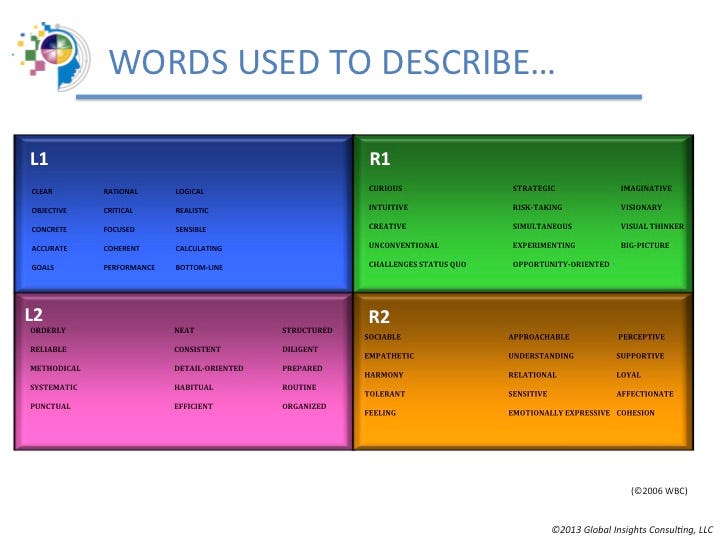https://medium.com/@FrontLineLeader/creativity-operationalized-f70a4abce1c5
In the post titled “Unleashing The Creative Mind” , the writer states “The challenge to most leaders comes in recognizing the outward signs of a creative mind, seeing the spirit of innovation for what it is rather than what it isn’t.” I agree. We need to operationalize creativity by identifying leaders who are creative, visionary thinkers and team them up with leaders that are critical and efficient. Together these leader teams will be designed to be more creative and innovative and put their ideas into action.
Using assessments like the Neethling Brain Instrument ( NBI), we can assess thinking preferences and determine what a person’s thinking preferences are. In general, right-brain people can be described as “creative and strategic” thinkers and left-brain people as more “detailed and analytical” thinkers. Neuroscience research shows that given a choice of left-brain vs. right-brain as well as high vs. low-road types of thinking tasks, there tends to be a correlation between what one prefers doing and those things with which one is skilled at. People tend to develop skills in the areas they prefer; which is not to say that they can’t develop skills in areas not aligned with their thinking preferences. It is like writing with your non-dominant hand. You can do it, and with practice you will be able to use that hand as well as your dominant hand but it will generally always feel awkward. Same thing goes for thinking preferences.
Below is a diagram with words used to describe the type of thinking that happens in each quadrant of the brain. I happen to be a very high R2, high R1, and average L1.

If you are a total left-brainer then you probably do not measure high in empathy or strategic thinking and if you are strictly right-brain you most likely are not a details-oriented or highly systematic person. As mentioned, people can develop skills in areas not aligned with their thinking preferences.
We need both kinds of thinkers in the Army, however, we need to be able to identify them. Now imagine if a Company Commander and First Sergeant were aware of their thinking preferences before they were paired as a team. They would have understanding of their individual thinking preferences as well as potential “blind spots” or areas for which they did not have a high preference. They would start off with a “shared understanding” of each other as well as the key leaders in the organization. The idea of the“complete leader” is a myth and it would allow leader development programs to deliberately help people develop their blind spots with Left-Brained and Right-Brained leader development programs. The same concept can be applied to staff positions. Imagine if Army staffs were INTENTIONALLY designed this way, with both the big-thinking, creative, visionary thinkers teamed up with the critical, analytical thinkers. They would be designed to win in a complex world.
As I wrote in this post, some industries in the corporate world have managed to operationalize creativity. The Army, and the military in general, can as well. The NBI (or equivalent) assessment can easily be tracked and could become part of the bigger talent management picture. Starting with Company Commanders and First Sergeants and working up through Brigade Commands to include Battalion and Brigade staff assignments, the Army can build teams that think more creatively.
No comments:
Post a Comment